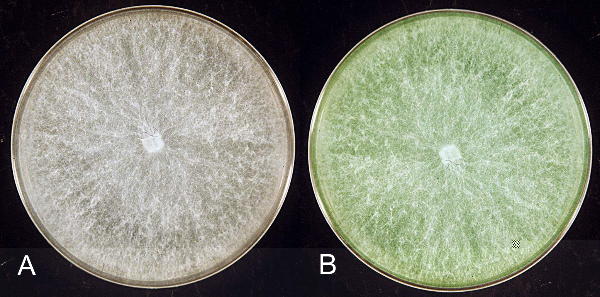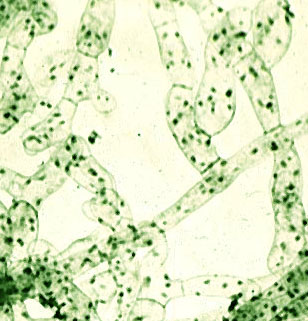Tom Volk's Fungus of the Month for April 2008
Please click
TomVolkFungi.net for the rest of Tom Volk's pages on fungi
This fungus was discovered in early 2008 by Gholan Faux, a noted Australian scientist at the University of New South Wales. While looking in the pouches of kangaroos at the mechanism of attachment of the joeys (baby kangaroos) to their mothers, he noted a white mycelium growing all through the pouch. There are certainly many kinds of microorganisms growing in such a warm, moist environment, but no one had ever noticed a fungus growing so prolifically in the pouch of a kangaroo previously. Naturally the first thing they did was to try to culture the fungus so that they could study it better in the lab.
When Dr. Faux started looking at more kangaroos, he noticed that some of them had a little green areas around their pouches. From these kangaroos, he isolated the same fungus! Apparently the fungus can grow on the skin and hair of the kangaroo, but also photosynthesize at the same time. It has never been observed to produce spores, so it is unclear how it is spread from kangaroo to kangaroo.
I hope you enjoyed learning about Profollias downhoki, the missing link fungus, with characters of both fungi and plants. I hope maybe to someday get to see a culture of this organism. It's very cool!
Updated April 1, 2008.
Click here for references.
 This month's fungus is Profollias downhoki, a recently discovered organism that is the missing link between fungi and plants. It is probably not surprising that this organism was found in Australia, being the home of hundreds of kinds of weird animals, plants and fungi. Many scientists go to Australia to study the wide range of strange creatures.
This month's fungus is Profollias downhoki, a recently discovered organism that is the missing link between fungi and plants. It is probably not surprising that this organism was found in Australia, being the home of hundreds of kinds of weird animals, plants and fungi. Many scientists go to Australia to study the wide range of strange creatures.
 When Dr. Faux and his lab associates tried to culture the fungus on standard lab media it failed to grow. So, considering the natural habitat of the fungus, they had to make a new kind of medium. They eventually cultured the fungus on kangaroo dextrose agar (KDA), where it grew quite well. However, they found a curious anomaly. When they grew the culture in the dark, it was a typical looking white mycelium. However, when they grew it in direct sunlight, it was green! Well if you've ever grown cultures of fungi you know that sometimes green conidia, the asexual reproductive structures of the fungus, form on the plate. This is what Dr. Faux assumed, but he told his graduate student, Gus BonSuguf, to take a look at the fungus to see if he could identify it. What Gus found, however, was shocking. There were no conidia, but the mycelium itself had turned green. Very strange!
When Dr. Faux and his lab associates tried to culture the fungus on standard lab media it failed to grow. So, considering the natural habitat of the fungus, they had to make a new kind of medium. They eventually cultured the fungus on kangaroo dextrose agar (KDA), where it grew quite well. However, they found a curious anomaly. When they grew the culture in the dark, it was a typical looking white mycelium. However, when they grew it in direct sunlight, it was green! Well if you've ever grown cultures of fungi you know that sometimes green conidia, the asexual reproductive structures of the fungus, form on the plate. This is what Dr. Faux assumed, but he told his graduate student, Gus BonSuguf, to take a look at the fungus to see if he could identify it. What Gus found, however, was shocking. There were no conidia, but the mycelium itself had turned green. Very strange!
 When Gus showed Dr. Faux the fungus under the microscope on high power, they noticed the green structures you see to the left. These hyphae have chloroplasts!! Shocking! Well. Dr. Faux was certainly excited, but he did not believe the results without some molecular biology. When they sequenced the fke region of the DNA of the chloroplasts from the hyphae, they found that it exactly matched the fke region of the DNA of the chloroplasts of mosses and green algae, indicating a common origin. However the DNA of the nuclei of the fungus indicated that the fungus belonged to the same taxonomic group as the dermatophytes, like Epidermophyton floccosum, which cause diseases such as athlete's foot and ringworm.
When Gus showed Dr. Faux the fungus under the microscope on high power, they noticed the green structures you see to the left. These hyphae have chloroplasts!! Shocking! Well. Dr. Faux was certainly excited, but he did not believe the results without some molecular biology. When they sequenced the fke region of the DNA of the chloroplasts from the hyphae, they found that it exactly matched the fke region of the DNA of the chloroplasts of mosses and green algae, indicating a common origin. However the DNA of the nuclei of the fungus indicated that the fungus belonged to the same taxonomic group as the dermatophytes, like Epidermophyton floccosum, which cause diseases such as athlete's foot and ringworm.
Of course there came the dilemma of what to call this new species. Dr. Faux decided to call it Profollias downhoki. Pro means before and follias refers to leaves, so Profollias means "before leaves," an appropriate name for a primitive plant. The epithet downhoki refers to an aboriginal name for this particular type of kangaroo, the Downhok, named in turn for its type of fur.
If you have anything to add, or if you have corrections, comments, or recommendations for future FotM's (or maybe you'd like to be co-author of a FotM?), please write to me at

This page and other pages are © Copyright 2008 by Thomas J.
Volk, University of Wisconsin-La Crosse.
Learn more about fungi! Go to Tom Volk's Fungi Home Page --TomVolkFungi.net